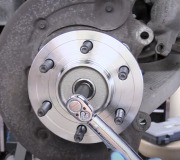First look at how you tightened the axle nuts. A lot of people put the wheels on, then set them on the ground to hold the axles from spinning. Doing that will instantly make the new bearings noisy. They must never have any weight on them unless the axle nut is torqued to specs with a click-type torque wrench. The second common mistake is some people just make those nuts tight but not with a torque wrench. The torque values are fairly critical. Most bearings call for around 180 foot pounds but some go as high as 240 foot pounds.
There is a tool you might be able to borrow or rent from an auto parts store that borrows them called the "Chassis Ear". It is a set of six microphones, a switch box, and headphones. You clip the microphones to suspect points, then drive around while listening with the headphones. You can move the microphones around to zero in on the source of the noise. Be aware that many mechanics have never seen or even heard of this tool. Suspension and alignment mechanics use it to find rattles, squeaks, and other noises.
Saturday, March 21st, 2015 AT 8:14 PM


